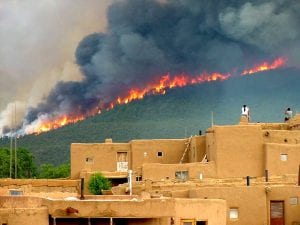Native American fire management at an ancient Wildland-Urban Interface
As residential development continues into flammable landscapes, wildfires increasingly threaten homes, lives, and livelihoods in the so-called ‘wildland-urban interface’ or WUI. Although this problem seems distinctly modern, Native American communities have lived in WUI contexts for centuries. When carefully considered, the past offers valuable lessons for coexisting with wildfire, climate change, and related challenges. Here we show that ancestors of Native Americans from Jemez Pueblo used ecologically savvy intensive burning and wood collection to make their ancient WUI resistant to climate variability and extreme fire behavior. Learning from the past offers modern WUI communities more options for addressing contemporary fire challenges. Public-private-tribal partnerships for wood and fire management can offer paths forward to restore fire-resilient WUI communities.
I recently published an interdisciplinary paper in Proceedings of the National Academy of Sciences that documents centuries of sustainable wood and fire use by Hemish people (Ancestral Pueblo) in the Jemez Mountains of northern New Mexico. You can find the article here or on my publications page.
Roos, Christopher I., Thomas W. Swetnam, T.J. Ferguson, Matthew J. Liebmann, Rachel A. Loehman, John R. Welch, Ellis Q. Margolis, Christopher H. Guiterman, William C. Hockaday, Michael J. Aiuvalasit, Jenna Battillo, Joshua Farella, and Christopher A. Kiahtipes (2021). Native American Fire Management at an Ancient Wildland-Urban Interface in the Southwest United States. Proceedings of the National Academy of Sciences 118(4): e2018733118.

Comments are Disabled